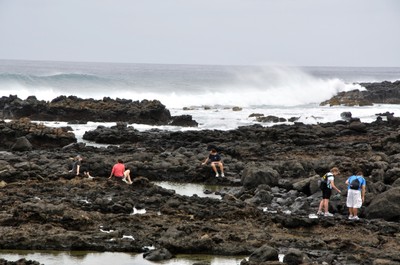I hate birds.
Well, perhaps hate is too strong. The feeling that comes up when I think of birds is probably more akin to jealousy. I’m a behavioral ecologist who studies cetaceans (whales, dolphins, porpoises) – this requires a lot of time and effort to gather and analyze data on cetaceans due to the difficult nature of studying animals which spend so little time at the surface of the water. Birds are really the stars of the behavioral ecology world (or so my ornithologist of an ecology professor taught me). Having said this, my jealousy of birds has slowly abated to a grudging respect… and competition. I figure the more I know about birds the less they can one-up my own studies. And the more accolades I can win from my professor for being the first to spot an indigenous Hawaiian bird, the Pacific Golden Plover (don’t worry, Andy, I won’t forget). So after all of this, why did I want to blog today about birds? Because, honestly, they are incredible.

This brings us to the subject of today: going out to Ka’ena Point Natural Area Reserve with Lindsay Young, Mike Lohr, and Andrew Titmus of Pacific Rim Conservation to take a look at Laysan Albatross and hopefully a monk seal or two. The day began with some rain on our way out to the North Shore, but thankfully decided not to rain on our excursion. Our day on Ka’ena Point also provided us with some hefty wind which knocked both us and the waves around quite a bit. It took us about one hour to hike out to the point from where we parked, during which we spotted several humpback whales just off the coast, here to mate and give birth in the much warmer waters of Hawai’i (as compared to their feeding grounds in Alaska).
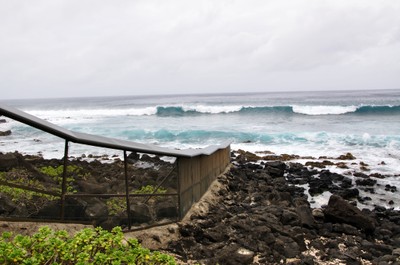
At the entrance to the Reserve we were greeted by a very impressive fence. This fence prevents all kinds of mammalian pests from entering the Reserve: no rats, cats, dogs, mongoose, or mice are in the Reserve. The few which manage to sneak their way through this fence are removed. Pacific Rim Conservation was inspired by a predator proof fence they saw in Tawharanui in New Zealand. This is the only predator free area on the island of O’ahu, making it a perfect place for birds to nest. Also in the reserve is the leina a ka ‘uhane, or Spirit Leap, where it is believed that spirits may leap into Po, the underworld.
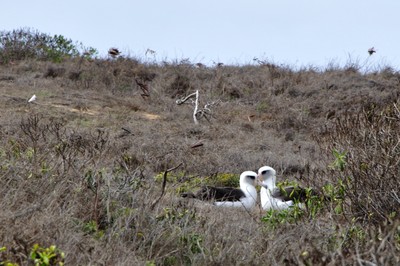
Soon after we entered the Reserve we saw some of our first nesting pairs of Laysan Albatross. The park is also trying to encourage Black Footed Albatross to nest at Ka’ena Point by using speakers which project their specific call, as well as decoys resembling the species.

After climbing a bit to walk further out to the point, we were blasted with even more wind, and were greeted by a spectacular view of some Great Frigatebirds. The wind was very strong and we had the fantastic view of several flying slowly right over our heads. The females have a white breast, while the males are all black and show a very impressive red pouch under their chins and necks which they inflate and waggle at the females to impress them.
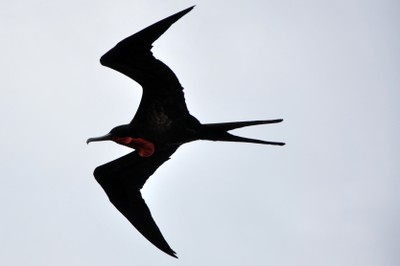
There are also wedge-tailed shearwaters that nest on Ka’ena Point, but don’t arrive until March. However, because their burrows remain, Dr. David Hyrenback (from our bird necropsies yesterday) from Hawaii Pacific University encouraged us to smell the burrows. And indeed we did! While we had some disagreements on what we could compare the smell too, we all agreed it was decidedly musty, but worth the stoop down. As we continued on our walk, a few Laysan Albatross took to the air, regaling us of their expansive wing span and beautiful forms.
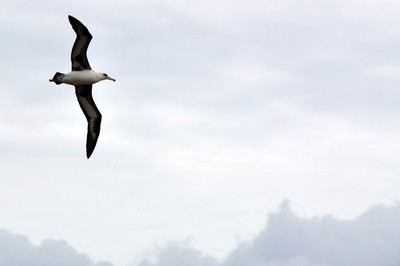
At the end of the path we were greeted with a cheerful sight: an endangered Hawaiian monk seal! There are just ~1,100 of these animals left and having the privilege to see a live, happy monk seal was a real treat. We saw a couple down in the rocky tidal zone as well during a quick scamper into the tidal zone filled with volcanic rock and weathered coral. After a little rest we returned the way we had come to ponder what the albatross and monk seals are going to look and act like on Midway Atoll.

